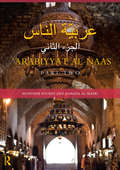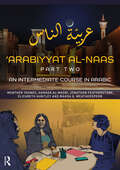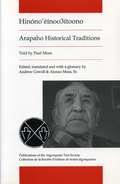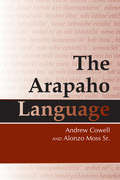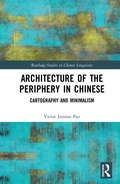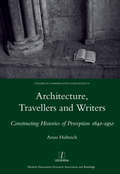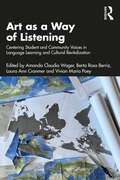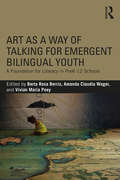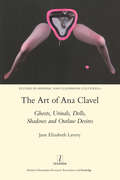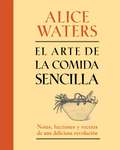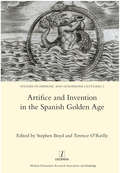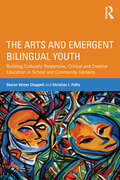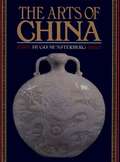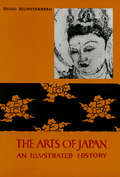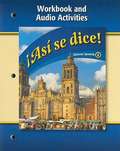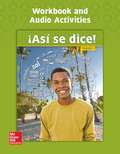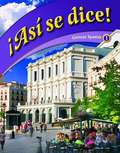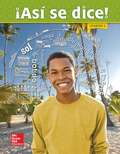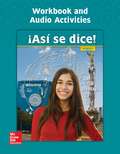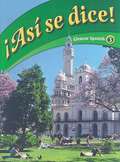- Table View
- List View
Arabiyyat al-Naas (Part Two): An Intermediate Course in Arabic
by Munther Younes Hanada Al-MasriArabiyyat al Naas (Part Two): An Intermediate Course in Arabic offers a vibrant course in Arabic as it is written and spoken today by educated native speakers. Not only does it continue the innovative integration of Modern Standard Arabic (MSA) and Levantine Arabic used in Part One of the series, but it does so in a way that supports and develops students’ increased mastery of the language. Combining a greater focus on cultural topics with an increased coverage of MSA, Part Two introduces more sophisticated communication, giving students a deeper awareness of the cultural base of the Arabic language. Features include: Twenty-one theme-based units covering a wide range of relevant and engaging topics, including education and learning, jobs and professions, the Arab woman, religion, money and the economy, politics and government and the environment Thorough coverage of listening, speaking, writing and reading skills in every unit, with lessons structured to provide students with variety, stimulation and further opportunities for practice Humorous, realistic dialogues reflecting everyday educated speech among Arabs to build up strong and practical communication skills A rich variety of reading passages, including poems, short stories, newspaper articles, descriptions of Arab cities and biographies of famous figures, designed to improve comprehension and analytical skills and to deepen students’ knowledge of Arab history, culture, language, and literature An extensive range of appealing exercises and activities, including crossword puzzles, root-and-pattern identification exercises, passage completions, guided and free compositions, and songs Free accompanying CD that includes audio recordings of the listening materials in the 21 units and a number of songs tied to their themes Free companion website (www.routledge.com/cw/younes) featuring the texts of the listening passages, the audio recordings available on the CD , a track list of all the audio materials, the answer keys to the crossword puzzles, sample tests and language games. Developed by an experienced and dynamic author team and tested over a number of years at Cornell University, Arabiyyat al Naas (Part Two) will be an essential resource for intermediate-level students of Arabic. While primarily designed for classroom use, the accessibility of the course also renders it highly suitable for independent study. This volume is the second in a pioneering three-part series of Arabic textbooks which together provide a complete three-year undergraduate language program.
'Arabiyyat al-Naas (Part Two): An Intermediate Course in Arabic
by Munther Younes Hanada Al-Masri Jonathan Featherstone Elizabeth Huntley Makda Weatherspoon‘Arabiyyat al-Naas (Part Two) is an Arabic language textbook designed to bring learners from a lower to a higher intermediate level of language proficiency. Using the Common European Framework Reference, it takes the learner from B.1 to B.2 and, in terms of the levels of the American Council on the Teaching of Foreign Languages, it takes the learner from Intermediate Low to Intermediate High/Advanced Low. The book is a continuation of the first level books in this series (either Arabiyyat al-Naas fii Bilaad al-Shaam or Arabiyaat al-Naas fii maSr ) and follows the Integrated Approach to Arabic instruction. It is a theme-based textbook delivered in the form of a serialized radio drama. Through the lens of journalism and personal interactions modelled by the main characters of this radio drama, learners are equipped to continue developing their spoken and written Arabic skills in the context of authentic dialogues and reading texts. As such, this book reflects cross-dialectal communication as used by native speakers across the Arab world.
'Arabiyyat al-Naas (Part Two): An Intermediate Course in Arabic
by Munther Younes Hanada Al-Masri Jonathan Featherstone Elizabeth Huntley Makda WeatherspoonArabiyyat al Naas (Part Two): An Intermediate Course in Arabic, second edition, offers a vibrant course in Arabic as it is written and spoken today by educated native speakers. It is a theme-based textbook delivered in the form of a serialized radio drama. Through the lens of journalism and personal interactions modelled by the main characters of this radio drama, learners are equipped to continue developing their spoken and written Arabic skills in the context of authentic dialogues and reading texts. As such, this book reflects cross-dialectal communication as used by native speakers across the Arab world.Features include: Twenty-one theme-based units covering a wide range of relevant and engaging topics Thorough coverage of listening, speaking, writing and reading skills in every unit, with lessons structured to provide students with variety, stimulation and further opportunities for practice Humorous, realistic dialogues reflecting everyday educated speech among Arabs to build up strong and practical communication skills Free companion website (www.routledge.com/cw/younes) featuring extensive audio recordings of the listening materials in the textbook, videos that supplement the textbook, and texts of the listening passages in the textbook Developed by an experienced and dynamic author team and tested over a number of years at Cornell University, Arabiyyat al Naas (Part Two) will be an essential resource for intermediate-level students of Arabic. While primarily designed for classroom use, the accessibility of the course also renders it highly suitable for independent study. Using the Common European Framework Reference, it takes the learner from B.1 to B.2 and, in terms of the levels of the American Council on the Teaching of Foreign Languages, it takes the learner from Intermediate Low to Intermediate High/Advanced Low.This volume is the second in a pioneering three-part series of Arabic textbooks which together provide a complete three-year undergraduate language program.
Arapaho Historical Traditions: Hinono'einoo3itoono (Algonquian Text Society)
by Alonzo Moss, Sr.Told by Paul Moss (1911-1995), a highly respected storyteller and ceremonial leader, these twelve texts introduce us to an immensely rich literature. As works of an oral tradition, they had until now remained beyond the reach of those who do not speak the Arapaho language. Here, for the first time, these outstanding examples of indigenous North American literature are printed in their original language (in the standard orthography used on the Wind River Reservation) but made accessible to a wider audience through English translation and comprehensive introductions, notes, commentaries and an Arapaho-English glossary.The Arapaho traditions chosen for this anthology tell of hunting, scouting, fighting, horse-stealing, capture and escape, friendly encounters between tribes, diplomacy and war, conflict with the U.S. and battles with its troops. They also include accounts of vision quests and religious rites, the fate of an Arapaho woman captured by Utes, and Arapaho uses of the "Medicine Wheel"in the Bighorn Mountains.
The Arapaho Language: Language And Power Among The Northern Arapaho
by Andrew Cowell Alonzo Moss, Sr.The Arapaho Language is the definitive reference grammar of an endangered Algonquian language. Arapaho differs strikingly from other Algonquian languages, making it particularly relevant to the study of historical linguistics and the evolution of grammar. Andrew Cowell and Alonzo Moss Sr. document Arapaho's interesting features, including a pitch-based accent system with no exact Algonquian parallels, radical innovations in the verb system, and complex contrasts between affirmative and non-affirmative statements. Cowell and Moss detail strategies used by speakers of this highly polysynthetic language to form complex words and illustrate how word formation interacts with information structure. They discuss word order and discourse-level features, treat the special features of formal discourse style and traditional narratives, and list gender-specific particles, which are widely used in conversation. Appendices include full sets of inflections for a variety of verbs. Arapaho is spoken primarily in Wyoming, with a few speakers in Oklahoma. The corpus used in The Arapaho Language spans more than a century of documentation, including multiple speakers from Wyoming and Oklahoma, with emphasis on recent recordings from Wyoming. The book cites approximately 2,000 language examples drawn largely from natural discourse - either recorded spoken language or texts written by native speakers. With The Arapaho Language, Cowell and Moss have produced a comprehensive document of a language that, in its departures from its nearest linguistic neighbors, sheds light on the evolution of grammar.
Architecture of the Periphery in Chinese: Cartography and Minimalism (Routledge Studies in Chinese Linguistics)
by Victor Junnan PanArchitecture of the Periphery in Chinese offers a comprehensive survey on the fine structure of the sentence peripheral domain in Mandarin Chinese from a cartographic perspective. Different functional projections hosting sentence-final particles, implicit operators and other informational components are hierarchically ordered according to the "Subjectivity Scale Constraint" functioning at syntax-discourse interface. Three questions will be essentially addressed: What is the order? How to determine such an order? Why such an order? This research not only gives a thorough examination of the peripheral elements in Chinese but also improves the general understanding of the ordering issue in the left-periphery crosslinguistically. This book is aimed at scholars interested in Chinese syntax or generative syntax.
Architecture, Travellers and Writers: Constructing Histories of Perception 1640-1950
by Anne HultzschDoes the way in which buildings are looked at, and made sense of, change over the course of time? How can we find out about this? By looking at a selection of travel writings spanning four centuries, Anne Hultzsch suggests that it is language, the description of architecture, which offers answers to such questions. The words authors use to transcribe what they see for the reader to re-imagine offer glimpses at modes of perception specific to one moment, place and person. Hultzsch constructs an intriguing patchwork of local and often fragmentary narratives discussing texts as diverse as the 17th-century diary of John Evelyn, Daniel Defoe's Robinson Crusoe (1719) and an 1855 art guide by Swiss art historian Jacob Burckhardt. Further authors considered include 17th-century collector John Bargrave, 18th-century novelist Tobias Smollett, poet Johann Wolfgang von Goethe, critic John Ruskin as well as the 20th-century architectural historian Nikolaus Pevsner. Anne Hultzsch teaches at the Bartlett School of Architecture, University College London.
Arma, tiro, bammm!
by Joan Mari Irigoien Aranberri?Hamzak, beraz, leherketa hura zuen jada buruan: izango ez zuen, bada, puntuari begira zegoela musika hura etorri bazitzaion, bamm bamm-bamm? musika hura, bai, gorputzean ere sentitzen zuena, bere gorputza zuhaitz bat balitz bezala, zainak adartzat zituena eta bere bihotz hura fruitutzat; bihotz hura, soka bakarreko lautak bezala, bamm-bamm-bamm egiten zuena, sistoleak eta diastoleak bat eginik; musika hura, segundo gutiren buruan erabateko bakera eraman zuena: BAMMM!? Hari bi nobela bakar berean: batetik, Bereibarko familia bat (Gipuzkoa eta Bizkaia arteko alegiazko herria) bizibidez eskopeta-lantegi bat daukana; bestetik, Balad al Xams-eko (Ekialde Hurbileko balizko herrialdea) beste familia bat, gerra ahaztu baten ondorioak nozitu beharko dituena; modu paraleloan kontatzen zaizkigu batzuen nahiz besteen pozak eta nekeak, eguneroko kontu xeheak eta Historia markatzen duten gertakari handiak, XX. mendeko bigarren erdian hasi eta gaur arte. Hari biek, halabeharrez, bat egiten duten arte. Ez da ohikoa arma trafikoa gaitzat hartzea eleberri batean; irakurlearen gogo-bihotzak inarrosteko asmo osoz egin du Joan Mari Irigoienek, eta helburu horri begira erabili bere artearen tresna guztiak. Hiru ezaugarriok nabarmendu daitezke egilearen lanean: hizkuntzaren erabilera zaindu eta ederra, hainbat istorio sortu eta kateatzeko fabulazio-ahalmen itzela, eta gure gizarteko gai minberak ukitzeko kontzientzia etikoa.
Art as a Way of Listening: Centering Student and Community Voices in Language Learning and Cultural Revitalization
by Amanda Claudia Wager Berta Rosa Berriz Laura Ann Cranmer Vivian Maria PoeyOffering a wealth of art-based practices, this volume invites readers to reimagine the joyful possibility and power of language and culture in language and literacy learning. Understanding art as a tool that can be used for decolonizing minds, the contributors explore new methods and strategies for supporting the language and literacy learning skills of multilingual students. Contributors are artists, educators, and researchers who bring together cutting-edge theory and practice to present a broad range of traditional and innovative art forms and media that spotlight the roles of artful resistance and multilingual activism. Featuring questions for reflection and curricular applications, chapters address theoretical issues and pedagogical strategies related to arts and language learning, including narrative inquiry, journaling, social media, oral storytelling, and advocacy projects. The innovative methods and strategies in this book demonstrate how arts-based, decolonizing practices are essential in fostering inclusive educational environments and supporting multilingual students’ cultural and linguistic repertoires. Transformative and engaging, this text is a key resource for educators, scholars, and researchers in literacy and language education.
Art as a Way of Talking for Emergent Bilingual Youth: A Foundation for Literacy in PreK-12 Schools
by Berta Rosa Berriz Amanda Claudia Wager Vivian Maria PoeyThis book features effective artistic practices to improve literacy and language skills for emergent bilinguals in PreK-12 schools. Including insights from key voices from the field, this book highlights how artistic practices can increase proficiency in emergent language learners and students with limited access to academic English. Challenging current prescriptions for teaching English to language learners, the arts-integrated framework in this book is grounded in a sense of student and teacher agency and offers key pedagogical tools to build upon students’ sociocultural knowledge and improve language competence and confidence. Offering rich and diverse examples of using the arts as a way of talking, this volume invites teacher educators, teachers, artists, and researchers to reconsider how to fully engage students in their own learning and best use the resources within their own multilingual educational settings and communities.
The Art of Ana Clavel: Ghosts, Urinals, Dolls, Shadows and Outlaw Desires
by JaneElizabeth LaveryAna Clavel is a remarkable contemporary Mexican writer whose literary and multimedia oeuvre is marked by its queerness. The queer is evinced in the manner in which she disturbs conceptions of the normal not only by representing outlaw sexualities and dark desires but also by incorporating into her fictive and multimedia worlds that which is at odds with normalcy as evinced in the presence of the fantastical, the shadow, ghosts, cyborgs, golems and even urinals. Clavels literary trajectory follows a queer path in the sense that she has moved from singular modes of creative expression in the form of literary writing, a traditional print medium, towards other non-literary forms. Some of Clavels works have formed the basis of wider multimedia projects involving collaboration with various artists, photographers, performers and IT experts. Her works embrace an array of hybrid forms including the audiovisual, internet-enabled technology, art installation, (video) performance and photography. By foregrounding the queer heterogeneous narrative themes, techniques and multimedia dimension of Clavels oeuvre, the aim of this monograph is to attest to her particular contribution to Hispanic letters, which arguably is as significant as that of more established Spanish American boom femenino women writers.
The Art of Chicago Improv: Short Cuts to Long-Form Improvisation
by Rob KozlowskiIn this book the author traces the history and growth of acting in Chicago.
El arte de la cocina sencilla
by Alice WatersDurante más de cuatro décadas, Alice Waters ha sido la máxima defensora de los alimentos locales de temporada producidos de forma sostenible. Ha sido aclamada globalmente y ha mostrado al mundo que el verdadero secreto de la buena cocina es comenzar con los ingredientes de mejor sabor. En El arte de la comida sencilla, Alice Waters aplica esta filosofía a 19 lecciones de cocina y a más de 250 recetas cotidianas que ilustran lo fácil que es comer maravi-llosamente bien si se cocina, se come y se vive según estas leyes fundamentales: Comer alimentos locales y sostenibles Comer alimentos de temporada Comprar en los mercados agrícolas Sembrar un jardín Conservación, compostaje y reciclaje Cocinar con simpleza Cocinar juntos Comer juntos Recordar que la comida es preciosa (Spanish translation of "The Art of Simple Food")
El arte de la cocina sencilla: Notas, Lecciones Y Recetas De Una Deliciosa Revolucion
by Alice WatersDurante mas de cuatro decadas, Alice Waters ha sido la maxima defensora de los alimentos locales de temporada producidos de forma sostenible. Ha sido aclamada globalmente y ha mostrado al mundo que el verdadero secreto de la buena cocina es comenzar con los ingredientes de mejor sabor. En "El arte de la comida sencilla," Alice Waters aplica esta filosofia a 19 lecciones de cocina y a mas de 250 recetas cotidianas que ilustran lo facil que es comer maravi-llosamente bien si se cocina, se come y se vive segun estas leyes fundamentales: Comer alimentos locales y sostenibles, Comer alimentos de temporada, Comprar en los mercados agricolas, Sembrar un jardin, Conservacion, compostaje y reciclaje, Cocinar con simpleza, Cocinar juntos, Comer juntos, Recordar que la comida es preciosa
Artifice and Invention in the Spanish Golden Age
by Stephen BoydThe corpus of literary works shaped by the Renaissance and the Baroque that appeared in Spain during the sixteenth and seventeenth centuries had a transforming effect on writing throughout Europe and left a rich legacy that scholars continue to explore. For four decades after the Spanish Civil War the study of this literature flourished in Great Britain and Ireland, where many of the leading scholars in the field were based. Though this particular 'Golden Age' was followed by a decline for many years, there have recently been signs of a significant revival. The present book seeks to showcase the latest research of established and younger colleagues from Great Britain and Ireland on the Spanish Golden Age. It falls into four sections, in each of which works by particular authors are examined in detail: prose (Miguel de Cervantes, Francisco de Quevedo, Baltasar Gracian), poetry (The Count of Salinas, Luis de Gongora, Pedro Soto de Rojas), drama (Cervantes, Calderon, Lope de Vega), and colonial writing (Bernardo Balbuena, Hernando Dominguez Camargo, Alonso de Ercilla). There are essays also on more general themes (the motif of poetry as manna; rehearsals on the Golden Age stage; proposals put to viceroys on governing Spanish Naples). The essays, taken together, offer a representative sample of current scholarship in England, Scotland, and Ireland.
The Arts and Emergent Bilingual Youth: Building Culturally Responsive, Critical and Creative Education in School and Community Contexts
by Christian J. Faltis Sharon Verner ChappellThe Arts and Emergent Bilingual Youth offers a critical sociopolitical perspective on working with emerging bilingual youth at the intersection of the arts and language learning. Utilizing research from both arts and language education to explore the ways they work in tandem to contribute to emergent bilingual students’ language and academic development, the book analyzes model arts projects to raise questions about “best practices” for and with marginalized bilingual young people, in terms of relevance to their languages, cultures, and communities as they envision better worlds. A central assumption is that the arts can be especially valuable for contributing to English learning by enabling learners to experience ideas, patterns, and relationship (form) in ways that lead to new knowledge (content). Each chapter features vignettes showcasing current projects with ELL populations both in and out of school and visual art pieces and poems, to prompt reflection on key issues and relevant concepts and theories in the arts and language learning. Taking a stance about language and culture in English learners’ lives, this book shows the intimate connections among art, narrative, and resistance for addressing topics of social injustice.
The Arts of China
by Hugo MunsterbergThe arts of China are products of the world's oldest continuous artistic tradition as well as one of its most brilliant. In this stimulating work, noted Oriental art authority Dr. Hugo Munsterberg traces the history of Chinese art dynasty by dynasty, elucidating the origins and development of major movements in painting, ceramics, bronzes, sculpture, and architecture. He clearly describes and defines the important trends and influences that culminated in the brilliant sculpture of the T'ang, the enchanting landscape paintings of the Sung, and the exquisite ceramics of the Ming. Outstanding examples of each genre are presented in over one hundred superb color and black-and-white photographs.
Arts of Japan
by Hugo MunsterbergArts of Japan was originally published by Tuttle Publishing in print form in 1957.<P><P> This book," in the words of the author, "represents an attempt to fill a long-felt need for an account of the history of Japanese art which would deal with the crafts as well as with the so-called fine arts and carry the story of Japanese art up to the present day instead of ending with the death of Hiroshige." The reader will quickly perceive how well this aim has been achieved. Here, in a stimulating and informative text and 121 well-selected plates -12 in full colour-is a dynamic treatment of the various influences that have shaped the course of Japanese art history in the fields of painting, sculpture, architecture, and handicrafts. Discussed with challenging insight are the impact of the various Indian and Chinese schools, the pervasive influenceof Zen philosophy, and the many other artistic developments, giving the reader awell-rounded picture of the great significance and contribution of Japanese art. Special features of the book are sections on handicrafts and a chapter on prehistoric art. The book comes at a time when there is an awakened interest in Oriental art throughout the world. At the same time new methods of art research have been so expanded and refined that many interpretations of earlier writers have been made obsolete. Because of linguistic barriers, political upheavals, and the limited number of specialists, misconceptions have been especially numerous in the field of Oriental art. THE ARTS OF JAPAN admirably corrects these misinterpretations, consolidates the results of the most recent scholarship, and in one compact volume presents an up-to-date, authoritative survey of Japanese an throughout its long history and in all its colorful diversity.
